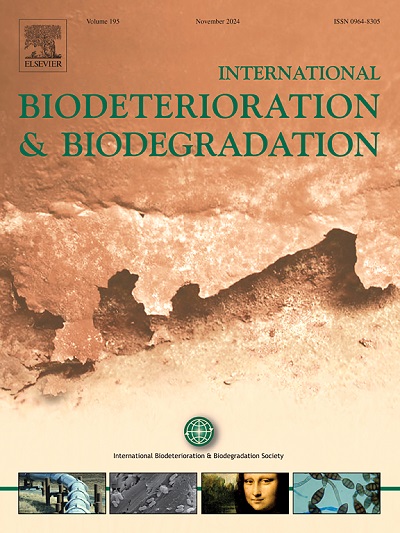盐球菌GUAg20降解甲壳类废弃物的研究一种几丁质分解和蛋白质分解的嗜盐古菌
IF 4.1
2区 环境科学与生态学
Q2 BIOTECHNOLOGY & APPLIED MICROBIOLOGY
International Biodeterioration & Biodegradation
Pub Date : 2025-04-18
DOI:10.1016/j.ibiod.2025.106102
引用次数: 0
摘要
海产品在满足全球粮食、营养和就业需求方面发挥着至关重要的作用;然而,渔业和水产养殖的快速增长带来了重大的环境挑战,特别是在管理海产品废物方面。传统的使用化学物质降解海产品废弃物会造成污染和生态失衡。因此,我们的研究通过从果阿盐田的盐晶体中分离并通过16S rRNA测序鉴定的嗜盐古菌盐球菌salsus来解决这个问题。将嗜盐古细菌菌株GUAg20应用于虾壳废弃物的生物处理,脱矿率达93.08%,失重率达65.7%。在发酵培养基中,观察5、10、15和20 d后n -乙酰氨基葡萄糖(NAG)的指数释放量分别为1.64 × 103、2.18 × 103、2.88 × 103和4.35 × 103 mg/L,证实了菌株GUAg20的几丁质降解活性。利用场发射扫描电镜(FE-SEM)和傅里叶变换红外光谱(FTIR)进一步证实了SSW的降解作用。本研究首次利用几丁质水解、蛋白水解和明胶水解的嗜盐古菌——盐球菌GUAg20进行海洋甲壳类废弃物的生物降解,同时将重点放在海鲜废弃物的管理上。本文章由计算机程序翻译,如有差异,请以英文原文为准。
Biodegradation of crustacean shell waste by Halococcus salsus GUAg20; a chitinolytic and proteolytic halophilic archaeon
Seafood plays a crucial role in meeting the global food, nutrition and employment demands; however, the rapid growth of fisheries and aquaculture has posed significant environmental challenges, especially in managing seafood waste. The traditional use of chemicals for seafood waste degradation causes pollution and ecological imbalance. Therefore, our study addresses this by exploring a halophilic archaeon, Halococcus salsus, isolated from salt crystals of the Goan saltpan and identified through 16S rRNA sequencing. The halophilic archaeal isolate GUAg20, was applied in the bioprocessing of shrimp shell waste (SSW) and resulted in its degradation with a high demineralization efficiency of 93.08 % and a weight loss of 65.7 %. In the fermentation medium, the chitinolytic activity of the isolate GUAg20 was confirmed by observing an exponential release of N-acetylglucosamine (NAG) corresponding to 1.64 103, 2.18 103, 2.88 103 and 4.35 103 mg/L after 5, 10, 15 and 20 days, respectively. The degradation of SSW was further confirmed using field emission scanning electron microscopy (FE-SEM) and fourier transform infrared spectroscopy (FTIR). This study reports the first use of Halococcus salsus GUAg20, a chitinolytic, proteolytic and gelatinolytic halophilic archaeon, for marine crustacean waste biodegradation, while concurrently focusing on seafood waste management.
求助全文
通过发布文献求助,成功后即可免费获取论文全文。
去求助
来源期刊
CiteScore
9.60
自引率
10.40%
发文量
107
审稿时长
21 days
期刊介绍:
International Biodeterioration and Biodegradation publishes original research papers and reviews on the biological causes of deterioration or degradation.

 求助内容:
求助内容: 应助结果提醒方式:
应助结果提醒方式:


